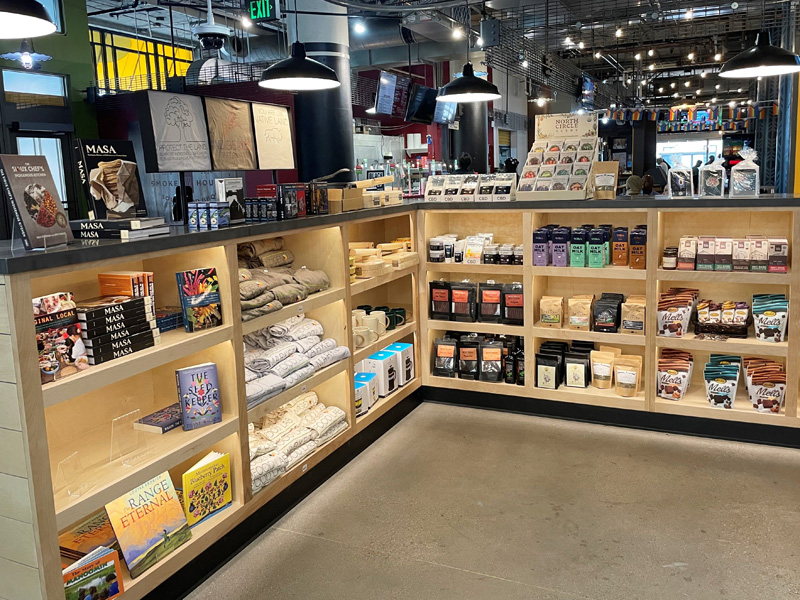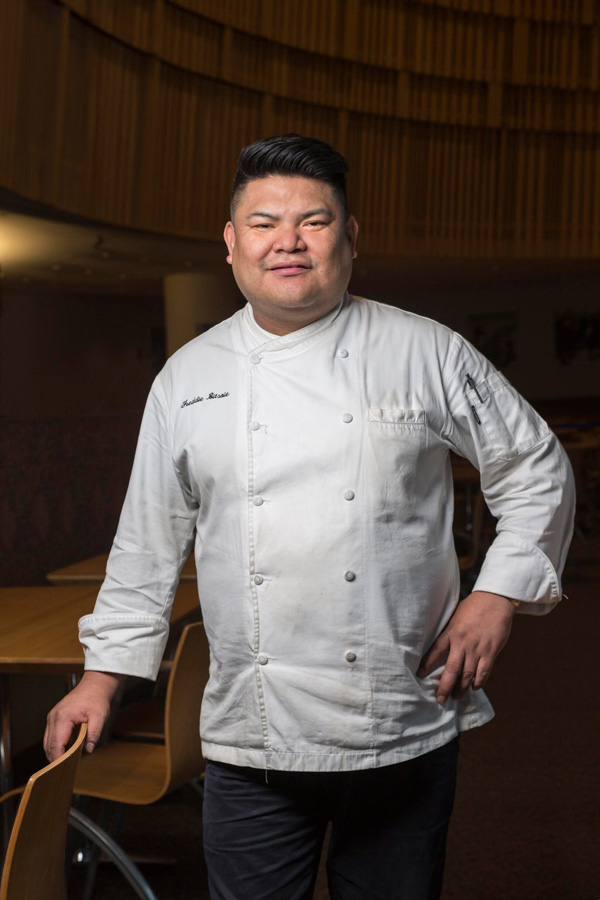This story originally appeared in Heavy Table’s Tap newsletter on Sep. 1, 2023. To get the Tap and three other culinary newsletters from the Heavy Table, back the magazine on Patreon.
Freddie Bitsoie is an award-winning chef, cookbook author, and through October, the first chef-in-residence at the Indigenous Food Lab (pictured below, photo by Stacy Brooks). The Indigenous Food Lab includes several components—a market stocked with Indigenous foods and products, a counter-service eatery, and a classroom—all with the goal of making Indigenous foods more accessible and supporting Indigenous entrepreneurs. For the next few months, Bitsoie will be lending his outside perspective to the project, as well as recording videos to add to the Indigenous Food Lab’s virtual education archive. We recently sat down with Bitsoie to learn more about his work and his approach to Native American cuisine.
Bitsoie, who is Navajo, was born in Utah and “raised all over I-40—I’ve lived in every city west of Albuquerque on I-40, all the way to California.” He majored in anthropology before leaving college to attend culinary school, and his externship at the J.W. Marriott in North Phoenix solidified his passion for the hospitality industry. “It was the best $8 an hour I’ve ever made in my life. I loved that job. It was so rewarding, it was so fun—the kitchen is the only place that has ultimate teamwork.”
A few years into his culinary career, Bitsoie was visiting Phoenix’s Heard Museum, an internationally-recognized collection of Native American art, when he spotted a poster advertising an upcoming event about Native American cuisine.
“The picture that they used was wild salmon with wild rice and a prickly pear sauce. And I thought, that looks pretty good, but if we claim that to be Native American cuisine, how can my grandmother relate to that? Because Navajos don’t eat cactus, Navajos don’t eat wild rice, Navajos don’t eat salmon.”
CRISS-CROSSING LINES OF TRAVEL AND INFLUENCE
Inspired by his background in anthropology, as well as Lidia’s Italy, a television show which focuses on Italy’s various regional cuisines, Bitsoie began to develop his own understanding of Native cuisine. He explains that U.S. culinary history is often flattened into an east-to-west story, starting with Plymouth Rock and culminating in the ideology of Manifest Destiny. However, the history of the United States—culinary and otherwise—is also a south-to-north story, due to Spanish and Portuguese colonization of South America, Central America, and modern-day Mexico, and a north-to-south story, with the French settling Canada’s Hudson Bay area and establishing wide-ranging trade networks. Bitsoie believes that an understanding of that complex history and its impact on Native American peoples is necessary to understanding Native American cuisine.
Bitsoie’s approach to Native American cuisine is also deeply informed by his belief that a dish needs to have a story behind it in order to be part of a culture. “There has to be more of a relationship to food than just the fact that we have to eat. That’s one thing that I think fundamentally is what I came to realize about Native American food: I can’t just pick berries and serve it with wild rice, and say here, eat. Because I don’t have a story for that, I don’t have any type of relationship to that.”

As an example, Bitsoie cites a salmon and prawn pozole that he made when he was working in Port Hardy, Canada, which is on Vancouver Island. The area’s First Nations peoples don’t typically eat corn (he had to source hominy from Idaho) and pozole is usually meat-based. However, the process of creating the recipe and sharing the dish with the community gave Bitsoie, as well as the local First Nations community, a relationship to the dish.
“Even though it’s not fully First Nations food, it has a story. And I will go to Mexico, and make it using whatever fish they have, and whatever prawns they have, and I will tell that story, and it will solidify it being a Native American dish.”
Stories that make a particular food part of Native American culture aren’t necessarily contemporary. Bitsoie notes that Navajo cuisine is heavily lamb and mutton-based, although domestic sheep are not indigenous to the Americas.
“The origin story of the sheep is that there was a very dense fog. It was so dense that people couldn’t see, they couldn’t even leave their hogans, their houses.”
“The fog lasted four days, because four is a sacred number to most tribes. When the fog lifted, there were little puffs of clouds left, and those were the sheep. [That story] gives the solidification that the sheep belong to us, and that there was divine intervention, rather than just saying they were stolen [from the Spanish] or given to us or whatever the history really was. If a culture has origin stories for an animal product that isn’t indigenous, to me, that’s phenomenal. That’s what’s important: it’s part of culture.”
THE FUTURE OF NATIVE FOOD
Bitsoie’s work in Native American cuisine has included a stint as executive chef at the Mitsitam Native Foods Cafe at the National Museum of the American Indian. He contributed to America: The Cookbook and Sioux Chef’s Indigenous Kitchen, and he is the co-author of New Native Kitchen, which was published in 2021.
“What makes [New Native Kitchen] different from most Native cookbooks is that it talks about how Native food is moving forward,” he explains. “So there’s wine as an ingredient, there’s different techniques involved in my food…There is a bit of history, there is a bit of talking about different tribes, but fundamentally it really talks about how Native American food is progressing.”
For instance, one of his recipes is based on a clam soup that originated about 800 years ago with tribes in what is now the Northeastern United States. Originally, it was prepared with three ingredients: seawater, sunchokes, and clams.
“My job is to interpret that old, old recipe and think how it possibly tasted to people 800 years ago—clearly, the sea was a lot cleaner then, clams tasted differently,” he says. “I don’t think anyone wants to drink seawater today. If I ate what my ancestors ate, I’d probably think it was gross and disgusting. I need the acidity, I need the olive oil, I need different types of flavor sensations. But I envisioned how [the clam soup] possibly might have tasted to people back then. I wrote a recipe where I assumed the sea tasted more like thyme.”
“[With contemporary Native American cuisine] there has to be a lot of assumptions, because of Native American relocation and changing of how people eat,” he continues. “The English, when they came, did a lot of slash-and-burn type things where they killed the Native peoples’ food. A lot of the food culture was missing from the middle of the 19th century to the beginning of the 20th century. Us as Native chefs have to try to redevelop how these foods might have tasted.”

